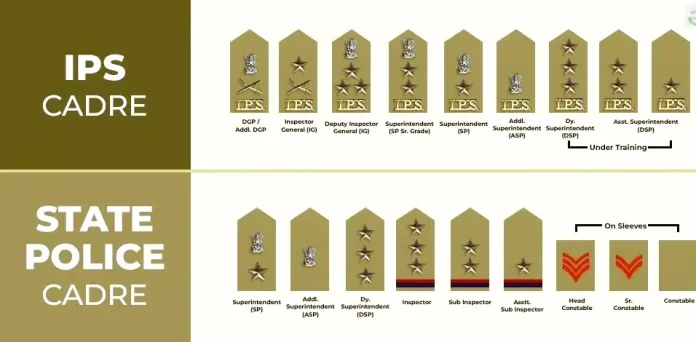In India, the police force follows a structured hierarchy that ensures the smooth functioning of law enforcement at various levels. Each rank within this hierarchy is associated with specific badges and insignia that signify the role and authority of police officials. These badges are worn on the uniform and play an important role in the identification and distinction of officers across the country. Below is an overview of the police officials’ badges and their hierarchy in India.
1. Director General of Police (DGP)
- Badge: The DGP’s badge features the national emblem, the Ashoka Chakra, and a special star. This signifies the highest rank in the state police force, symbolizing leadership and authority.
2. Additional Director General of Police (ADGP)
- Badge: The ADGP badge is similar to that of the DGP, with slight modifications in design. They typically wear a star and the Ashoka Chakra emblem.
3. Inspector General of Police (IGP)
- Badge: The IGP badge features the Ashoka Chakra along with a star. The star signifies their seniority in rank, as they oversee police regions or large divisions.
4. Deputy Inspector General of Police (DIG)
- Badge: DIGs wear a similar badge to IGPs, but with a minor distinction in the star. The badge reflects their responsibility in managing law enforcement at a higher administrative level.
5. Superintendent of Police (SP)
- Badge: The SP wears a badge with a silver star. It symbolizes their leadership role in a district or city, overseeing all law enforcement matters within their jurisdiction.
6. Deputy Superintendent of Police (DSP)
- Badge: The DSP wears a badge with a single silver star, which signifies their responsibility in overseeing a sub-division of the police station and assisting the SP.
7. Inspector
- Badge: Inspectors wear two silver stars on their epaulettes. They are responsible for leading police stations, investigations, and maintaining law and order within their respective areas.
8. Sub-Inspector (SI)
- Badge: The SI badge has a single star. Sub-Inspectors assist inspectors in their daily functions and often take charge of police station operations.
9. Assistant Sub-Inspector (ASI)
- Badge: The ASI wears a badge with a single chevron or horizontal stripe, marking them as a junior officer who assists higher-ranking officers in managing the police force.
10. Head Constable (HC)
- Badge: The HC badge typically has a single chevron or a similar insignia to signify their seniority among constables and their supervisory role.
11. Constable
- Badge: Constables do not wear specific badges of rank, but their uniform consists of the standard police attire. They serve as the foundation of the police force, performing duties on the ground.
Badges and insignia in the Indian police force play an important role in identifying officers’ ranks and responsibilities. The hierarchical structure ensures that each officer knows their role and authority within the system. From constables to the Director General of Police, each badge reflects the officer’s position and their responsibilities in maintaining law and order.

